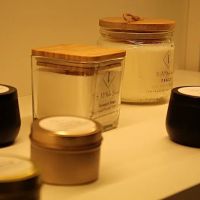How to Avoid Soot Buildup in Scented Candles: Tips for a Cleaner Burn
- Understanding Soot Buildup in Scented Candles
- Why Does Soot Buildup Happen in Scented Candles?
- Common Causes of Soot in Candles
- How to Prevent Soot Buildup in Scented Candles
- Real-Life Experience: Avoiding Soot Buildup in Candles
- Where to Buy Clean-Burning Scented Candles
- Buy the Best Scented Candles for Clean Burning
Understanding Soot Buildup in Scented Candles
Soot buildup is a common issue faced by candle enthusiasts, especially when using scented candles. Soot is essentially fine, black particles that are created when a candle burns incompletely. These particles can leave marks on your walls, furniture, and even your lungs if the candle is not burned properly. While it's inevitable to have a little soot when burning candles, excessive buildup can detract from your candle’s appeal and create an unhealthy environment.
Why Does Soot Buildup Happen in Scented Candles?
Soot buildup occurs when the candle flame doesn’t burn efficiently. In a perfect burn, the candle wax is turned into gas, and the wick burns cleanly. However, when this process is disturbed, carbon particles are released, which are what you see as soot. There are several reasons why this may happen, such as the type of wax used, the wick material, or even how you burn the candle.
Understanding why soot forms in scented candles can help you identify the best ways to prevent it, ensuring that your candles provide a cleaner, more enjoyable burn.
id="common-causes-of-soot">Common Causes of Soot in Candles
1. Poor Quality Wax
Cheap paraffin wax is one of the leading culprits behind soot production. When burned, paraffin can release harmful chemicals and soot, especially if it’s not pure. Opting for high-quality waxes, such as soy wax or beeswax, can drastically reduce the soot buildup and improve your candle’s overall performance.
2. Improper Wick Size
The wick size plays a major role in how cleanly a candle burns. A wick that is too large can cause the candle to burn too hot, leading to excessive soot. Conversely, a wick that is too small might not burn the wax completely, creating smoke and soot. It's essential to choose a candle with an appropriately sized wick for optimal burning.
3. Burning Candles in Drafty Areas
Burning candles in drafty spaces can cause the flame to flicker and burn unevenly, increasing soot production. To ensure a clean burn, keep your candles away from open windows, vents, or air conditioning units.
4. Incorrect Candle Maintenance
Failure to trim the wick regularly can also lead to soot buildup. A long wick causes the candle to burn unevenly and might create an unstable flame that leads to more soot. It’s recommended to trim your wick to about 1/4 inch before lighting each time.
How to Prevent Soot Buildup in Scented Candles
Preventing soot buildup is not only about choosing the right candle but also about maintaining it properly. Here are some effective tips for reducing soot production and ensuring a cleaner burn:
1. Choose High-Quality, Natural Wax Candles
Opting for candles made from natural, non-toxic waxes like soy wax, beeswax, or coconut wax can significantly reduce soot buildup. These waxes burn cleaner than paraffin wax and don’t release harmful chemicals into the air.
2. Trim Your Wick Regularly
Before each use, trim your candle’s wick to around 1/4 inch. A shorter wick will help the candle burn more evenly and reduce the risk of excessive soot. If you notice that the flame is too large or flickering, trim the wick immediately.
3. Burn Candles in Well-Ventilated Areas
Ensure that the area around the candle is free of drafts. A stable environment allows the candle to burn evenly and reduces soot formation. Keep your candles away from fans, open windows, or air conditioning units.
4. Use Candles with Proper Wick Size
Choose candles with wicks that are appropriate for their size and wax type. Too big or too small a wick can cause problems with soot buildup. Look for candles from trusted brands that ensure the wick size matches the candle’s overall design.
5. Don’t Burn Candles for Too Long
Allow your candles to burn for about 3-4 hours at a time. If burned for too long, candles can develop excessive carbon buildup, which leads to soot. After 3-4 hours, extinguish the candle and relight it later if you wish.
Real-Life Experience: Avoiding Soot Buildup in Candles
When I first started using scented candles, I often noticed a build-up of black soot on the walls near where I had placed them. After researching, I learned that the type of wax and wick was crucial in preventing soot. I switched to a high-quality soy wax candle with a cotton wick, and now I don’t have any issues with soot buildup. It’s made a noticeable difference not just in the cleanliness of my home, but also in the overall air quality.
Where to Buy Clean-Burning Scented Candles
If you want to avoid soot buildup in your scented candles, it's important to choose high-quality, natural candles. For premium options, visit Scent Snob, where you can find a variety of clean-burning, eco-friendly candles made with soy wax, beeswax, and other non-toxic materials.
Buy the Best Scented Candles for Clean Burning
Ready to experience a soot-free candle burn? Click here to explore our collection of high-quality, non-toxic scented candles that provide a cleaner, more enjoyable burn every time. Enjoy the soothing scents without worrying about soot buildup!



0 comments